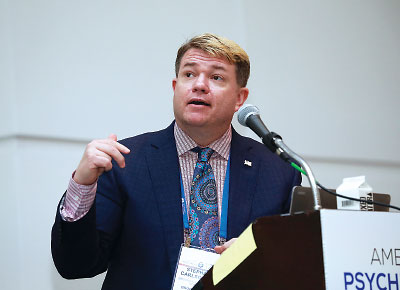Experts Describe Community Approaches to Reducing Gun Violence
Abstract
Speakers touched on the positive impact of urban revitalization projects but also discussed some cautionary outcomes related to mental illness on college campuses.
At an APA Annual Meeting session on the public health impact of gun violence on America’s youth and young adults, presenters shared recent developments that are both positive and negative. The session was sponsored by the American Society for Adolescent Psychiatry.
On the plus side, session chair Stephan Carlson, M.D., an assistant professor of psychiatry at New York Medical College, highlighted a pair of ideas that are helping at-risk urban communities proactively address the problem of gun violence among youth.

Stephan Carlson, M.D., discusses how community remediation strategies like cleaning up vacant lots and abandoned buildings offer an easily implementable and cost-effective approach to reducing gun violence.
The first approach Carlson discussed is urban remediation, which involves using inexpensive methods to renovate unused city lots, abandoned buildings, and other blighted neighborhood areas. Residents in these communities frequently note that gangs tend to congregate in these vacant, abandoned sites. “For residents who live around the vacant areas, that means spending less time outside, less time socializing with neighbors, and less time being a community,” he said.
The renovations may seem like minor cosmetic adjustments, but many studies published over the past couple of years from communities across the United States have found that urban-remediation efforts can both reduce gun violence and other crimes like vandalism and increase time that residents spend outdoors.
The second strategy, known nationally as Cure Violence, borrows from principles of infectious disease control to prevent and respond to violence. The program focuses on detecting problems early, identifying individuals at high risk, and changing social norms to reduce future outbreaks.
For example, community residents with some forensic background are trained to serve as violence disruptors who can help deescalate tense situations before any guns are drawn. If gun violence does occur, the disruptors and other personnel work to get the community aware and involved positively through, for example, neighborhood meetings to discuss the incident and identify solutions to prevent a repeat event.
As with urban remediation, Cure Violence has shown meaningful results in numerous communities. One case example is the Brooklyn neighborhood of Brownsville. In addition to training violence disruptors and holding neighborhood meetings, the Brooklyn program offered access to mental health services for individuals at risk of violence as well as those who had witnessed a violent encounter.
Carlson noted that after implementation of the project, homicides dropped by 18% between 2010 and 2013 in Brownsville. In comparison, the nearby Brooklyn neighborhood of Flatbush, which had not implemented a Cure Violence program, experienced a 69% increase in homicides during this period.
The goal of keeping communities safe was also broached in the presentation of Connor Darby, M.D., a psychiatrist at the University of California, Los Angeles (UCLA). He focused on the college campus community and some recent state Supreme Court cases that could influence how these institutions approach gun-violence prevention.
Darby discussed two cases that involved civil suits against UCLA and the Massachusetts Institute of Technology (MIT). The former involved a student who was physically attacked by a fellow student with a knife, and the latter involved the suicide of a graduate student. Both the attacker and suicide decedent had a history of mental illness, though school officials did not suspect any imminent threat of violent or suicidal behavior.
In both instances, the state courts ruled that universities have a responsibility to protect students from “foreseeable” acts of violence and that they can be sued if they fail their responsibility. The decisions left some ambiguity as to what constitutes “foreseeable,” which Darby noted could lead universities to develop “overreactive” policies to be compliant.
Though the two cases did not specifically involve guns, Darby said that the specter of gun violence will undoubtedly weigh heavily on future decisions made by universities when considering policies to prevent on-campus violence, as firearms are one of the leading causes of death of young people. In fact, the California Supreme Court cited the 2007 Virginia Tech mass shooting as a case where a university failed to act proactively.
One might think that universities could simply prohibit firearms on campus as one protective measure, since there is ample evidence that easy gun access is a risk factor for violence. However, Darby cited other legal cases that ruled that public universities do not have the authority to prohibit carrying legal firearms on campus.
“Does that mean universities might [overreact and] screen out students with a mental health issue to avoid liability or develop more aggressive policies toward such students on campus?” he wondered. ■
Information about Cures Violence is posted here.



